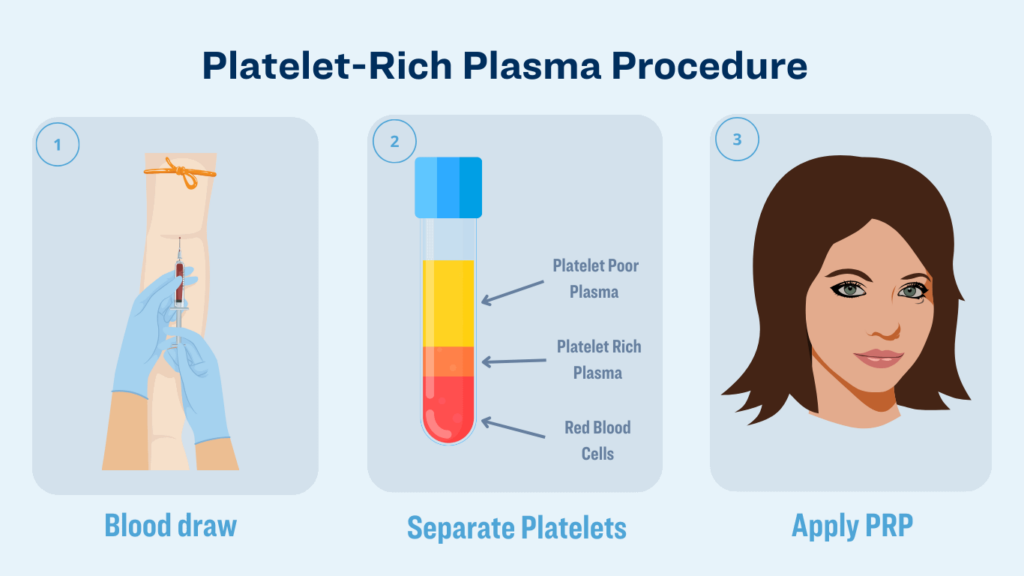Platelet-Rich Plasma (PRP) Treatments
Reviewed by Dr. Connie Casebolt, MD MPH of Forum Health Greenville
What is Platelet-Rich Plasma (PRP)?
PRP, or Platelet Rich Plasma treatment is a cutting-edge approach to help you recover from injuries, alleviate pain, rejuvenate sexual health, hair and skin, and promote overall wellness.
By utilizing your body’s own healing properties to accelerate tissue repair and regeneration, PRP can be a safe and effective natural alternative to surgeries and other invasive procedures.
Platelet-Rich Plasma involves extracting a small sample from your blood, which is then processed to concentrate the platelets, activated through Forum Health’s unique process, and made available for use.
Platelets are rich in growth factors and other bioactive proteins that play a crucial role in tissue repair and regeneration. Once the platelets are concentrated and activated, they are applied topically or injected into the targeted area of the body, where they stimulate the natural healing process.

What are PRP Treatments for?
PRP can be used after surgeries or injuries and may help regenerate tissue to improve mobility, reduce healing time, and restore. Platelet-rich plasma treatments are common for:
- Joint pain
- Tendon injuries (tendonitis, tendon tears)
- Ligament injuries (sprains, strains)
- Osteoarthritis
- Sports injuries
- Chronic pain conditions
- Hair loss (male and female pattern baldness)
- Dark facial spots, fine lines, and wrinkles
- Acne scars
- Erectile dysfunction and Peyronie’s disease
- Vaginal laxity
- Urinary incontinence issues
- Diminished libido
The Benefits of Getting a Platelet-Rich Plasma Treatment:
Improved Tissue Healing
Studies show that using PRP after surgeries helps to reduce healing time. Because PRP contains large amounts of blood-derived growth factors, the treatment helps to heal damaged tissue naturally.
These growth factors can help stimulate collagen production and new vessel growth, and increase the amount of cell growth.

Hair Restoration
The ability of PRP to regenerate tissue, has been shown to be an effective treatment for both male and female hair loss, as well as alopecia.
“Several studies have shown that PRP can be used effectively for treatment of hair loss.”
–Anon Paichitrojjana and Anand Paichitrojjana, Platelet Rich Plasma and Its Use in Hair Regrowth: A Review

Skin Rejuvenation
PRP has been used in dermatologist-grade beautifying procedures, popularized by modern techniques for facials. Studies have shown PRP is an effective treatment option for:
- Reducing darkness around the eyes
- Minimizing wrinkles around the eyes (crows feet)
- Reducing the appearance of nasolabial folds
- Restoring lost volume due to aging

Vaginal Rejuvenation
PRP is used to stimulate the growth of new cells in the clitoris and vagina to:
- Improve sensitivity and clitoral stimulation
- Produce stronger and more frequent orgasms
- Increase natural lubrication
- Improve urinary incontinence
- Decrease discomfort for those experiencing painful sex

Penile Enhancement
PRP promotes the growth of new cells to rejuvenate the penis for those experiencing erectile dysfunction or have been diagnosed with Peyronie’s disease.
- Increases firmness of erections, blood flow and circulation
- Increases sexual stamina, sensation and pleasure
- Improves or resolves prostate discomfort and urinary incontinence

PRP Procedure
Blood sample collection
The first step is to collect a small amount of blood. This is usually done from a vein in the arm, like a blood test. Usually, 30-60mL of blood will be taken for PRP injections.
Centrifugation to separate PRP from blood
The blood that has been collected is then placed in a centrifuge, a machine that spins rapidly to separate the platelet-rich plasma from other blood components.
Topical anesthesia at injection site
Depending on what the PRP is used for, your doctor may offer you topical numbing to make the procedure as comfortable as possible. For example, if you are using PRP for penis enlargement, or undergoing PRP vaginal rejuvenation, you may be offered topical anesthetic.
Injection or application of PRP to target area
The concentrated platelet-rich plasma is collected and prepared for injection or topical application through microchannels created with a micro-needling tool.
Side Effects of PRP Treatment
Since PRP treatment involves using your own blood, there is a low risk of allergic reaction or infectious disease spread, and they are generally considered as being a very safe procedure.
There are some minor risks involving pain or discomfort where the PRP is injected or applied, some swelling or bruising, and infection if the procedure has not been performed in a sterile environment.
“PRP is relatively noninvasive, has a well-established safety profile, and patient satisfaction is often high”
If you’re interested in exploring PRP injections, it’s essential to have a thorough discussion with your healthcare provider to understand the potential benefits and risks.
*Research into PRP’s diverse applications is rapidly expanding and shows encouraging results. While the FDA has cleared the equipment for PRP preparation and the injection process itself, most uses of PRP remain classified as investigational. Because PRP comes from your own blood, it’s not categorized as a drug. FDA clearance allows doctors the flexibility to recommend and use PRP when they deem it beneficial for their patient. However, as it lacks full FDA approval, insurance companies may not cover the cost of PRP treatments.
PRP Treatment FAQs
How long do PRP treatments last?
The effects of PRP are often not permanent and vary depending on the condition being treated.
Usually, however, the treatment effects last a few months. Repeat treatments are often recommended to maintain or enhance results.
How many times should I do PRP?
This depends on the procedure, how many benefits you experience from it, and the opinion of your doctor.
While some conditions benefit from a single treatment, most will need repeat treatments over the course of a few weeks, or months, to see maximum results
Is PRP painful?
PRP injections or applications are not painful. If you have had a blood test and injections, then that is the level of pain you can expect.
Some clinicians will offer to give you local anesthetic in sensitive areas or if you require numerous treatments. If you are uncomfortable with needles, you can discuss this option with your physician.
How does PRP work to promote tissue regeneration and healing?
PRP takes the cells from your blood responsible for clotting and healing and injects or applies them right where your body needs them most. PRP contains growth factors to help increase the number of regeneration cells, stimulate collagen production, and have anti-inflammatory effects.
Citations:
Paichitrojjana A, Paichitrojjana A. Platelet Rich Plasma and Its Use in Hair Regrowth: A Review. Drug Des Devel Ther. 2022 Mar 10;16:635-645. doi: 10.2147/DDDT.S356858. PMID: 35300222; PMCID: PMC8922312.
Banihashemi M, Zabolinejad N, Salehi M, Hamidi Alamdari D, Nakhaizadeh S. Platelet-rich Plasma use for facial rejuvenation: a clinical trial and review of current literature. Acta Biomed. 2021 May 12;92(2):e2021187. doi: 10.23750/abm.v92i2.9687. PMID: 33988167; PMCID: PMC8182581.
A comprehensive review of platelet-rich plasma for the treatment of dermatologic disorders
Jessica N. Pixley– Wake Forest Department of Dermatology


